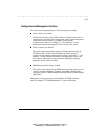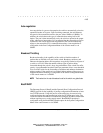
. . . . . . . . . . . . . . . . . . . . . . . . . . . . . .
1-14 Overview
Writer: Fran Spragens Project: Overview Comments: 355307-002
File Name:3324_1.doc Last Saved On:3/16/99 11:31 AM
LEDs
The port LEDs on the switch provide a quick and accurate display of the
integrity of switch connections and switch mode. The operation of the RJ-45
port LEDs can be changed by use of the LED mode button on the switch front
panel. The LED mode button does not affect the operation of the fiber port
LEDs. The default operation of the RJ-45 LEDs indicates Link (L) and
Activity (A) for each of the ports. When the LED mode button is pressed
(pressed and held in), the operation of the RJ-45 LEDs changes to indicate
full/half duplex and 10/100 Mb/s speeds, respectively.
Full Duplex Mode
The full duplex mode of operation on a port can double the throughput of
switch connections. This mode disables the collision detection portion of the
Ethernet Carrier Sense Multiple Access with Collision Detection (CSMA/CD)
protocol, allowing for two-way traffic. Full duplex is configurable using the
Duplex Mode parameter in the Port Menu of the console menus or via SNMP.
Flow Control
Flow control allows you to manage network traffic during congestion periods
and to prevent the loss of packets when port buffer thresholds are exceeded.
The SW3322/SW3323/SW3324 can receive pause frames being sent to it, and
stop sending traffic on that port. You can configure this ability to receive and
respond to pause frames on a port-by-port basis. The switch receives pause
frames per the IEEE 802.3x standard.
Virtual LANs (VLANs)
VLANs allow you to connect users to a specific LAN segment regardless of
their physical location. The switch supports tagged VLANs per the IEEE
802.1Q draft standard. With frame tagging, a short tag is appended to every
frame that crosses the network backbone. The tag identifies which VLAN the
frame belongs to. See Appendix C, “Virtual LANs (VLANs),” for more
information about this feature.


















